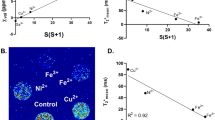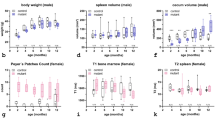Abstract
For the first time, change in the proton longitudinal relaxation times (T1) of rat tissues has been examined throughout the whole process of azo-dye hepatocarcinogenesis. Two maxima of the T1 values were observed for liver, on Day 60 and after Day 120, and these changes correlated well with the changes in water content. The first peak was ascribed to the immature hepatocytes of hyperplastic nodules, and the second peak to the developed hepatoma cells. The significance of the change in T1 values as a preneoplastic change is discussed.
This is a preview of subscription content, access via your institution
Access options
Subscribe to this journal
Receive 24 print issues and online access
$259.00 per year
only $10.79 per issue
Buy this article
- Purchase on SpringerLink
- Instant access to full article PDF
Prices may be subject to local taxes which are calculated during checkout
Similar content being viewed by others
Rights and permissions
About this article
Cite this article
Kodama, M., Ohki, T., Saitô, H. et al. Biphasic change of proton magnetic relaxation times during azo-dye hepatocarcinogenesis. Br J Cancer 38, 233–236 (1978). https://doi.org/10.1038/bjc.1978.193
Issue Date:
DOI: https://doi.org/10.1038/bjc.1978.193



